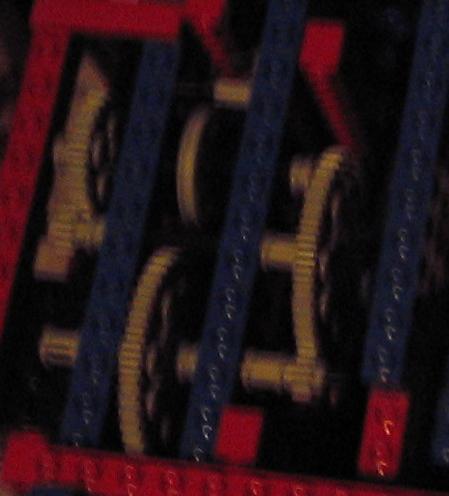The Side View
THE TEAM:
Oliver
Yeh, Herman Mutiso and Tuan Huynh
THE NAME:
Just in
case you are wondering, the first word in ‘HOT CREW’ is a combination of our
first name initials J
THE ROBOT
At the beginning of IAP, we were 'sure’ what
we wanted the robot to look like. By the time it was impounded, the little
machine had undergone more changes in its overall structure than one would care
to recall.
The end product was an artificial
'cheetah', a machine built to traverse the board's terrain at breakneck speed.
Although built with a gear ratio of
75:1, we opted for a unique bracing style: instead of mounting small lego piece
after small lego piece, it was decided to rely on longer beams to hold the
robot together. End result: one light-weight, lean machine that moved at
lightning speed. So fast was this...this...fiend from hell that we had to run
the motors at half speed in order to keep track of it.


The Gear Train
The extra wheels (‘un-rubbered’
ones) were designed to serve a three-fold purpose. One, act as bump sensors; in
case we bumped into walls or opponents' robots, two: prevent the beams that
were attached to the bump sensors from constantly scraping against the ground
and three; act as a snake-collector (doesn't this remind you of the movie: the
bone collector, with that good looking actress, what was her name again?). By
snake collector is meant a pushing device that was meant to collect the snakes
and place them in the hills.
Other than the bump sensors, team
'hot crew' also made use of a distance sensor as a means of orienting itself,
unlike most teams which made use of infra-red sensors. This is how it worked:
There are four unique combinations for four different possible starting
positions. The sensors were hugely
inaccurate and it was only possible to tell if an obstacle was very far away or
very close. Our code directed the happy board to treat distance sensor readings
of 2150 or below as 'far' and 2151 or above as 'close'. Using this, the ‘bot
could figure out which direction to take in order to get to either the two
snakes or the four snakes.
STRATEGY
Complex strategies greatly increase
the number of things that can go wrong and make it increasingly difficult for
the robot to work consistently. With this in mind, we decided from day one to
adopt a simple strategy and spend most of the time ensuring the 'bot moved
predictably and consistently. Little did we know how much time we actually had.
The approach was to dash across the
length of the board, trap the four snakes and leave them in the hill at the
opposite side of the board, before going for our other 2 snakes and placing
them in the center hill. We reasoned that it would be remarkably harder to
score in the hill at the center than at the other 2 hills. So if we scored in
the central hill, we would almost be guaranteed of one scoring zone. Since our robot was one of the fastest, we
could get through these two stages of our strategy before our opponents could
get to part two of their strategy.
Lastly, the robot would go to the
last scoring zone, clear all the opponents' snakes and remain there, patrolling
the region to ensure that the opponents' 'bot did not manage to win the region.
This meant that unless the opponent ‘bot could clear the hill in which we had
placed our four snakes and then place their four snakes in the central zone,
then we were practically assured of victory.
THE RESULTS
I always believed firmly in the idea
that its the effort that counts. We gave
the robot our best shot and sold our time for the advancement of it. But alas, we could not collect the fruits of
our labor. We were part of the 1/4 of
the teams who went two and out. In our
first match, we were disqualified because of our 60 second code did not work.
In our last match, our robot did an very interesting move. Because of its anti-stuck codes, it would
move forward and backwards when its wheels stop moving. So when our robot somehow got stuck on top of
the other robot, it did motions very similar to humping. That was the highlight of the night. On the Behalf of my team, I would like to
thank the organizers, Teacher Assistants, and all those who have contributed in
making 6.270 such a successful and engaging class. The existence of 6.270 would not have been
possible without the help of you guys.